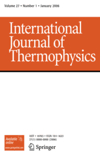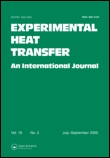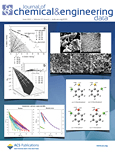
INTERNATIONAL JOURNAL OF THERMOPHYSICS
Scope & Guideline
Illuminating the Path of Thermal Research
Introduction
Aims and Scopes
- Thermophysical Properties Measurement:
The journal focuses on the accurate measurement and characterization of thermophysical properties such as thermal conductivity, viscosity, density, heat capacity, and diffusivity across various materials and states. - Experimental and Theoretical Techniques:
Research often employs a combination of experimental methods (e.g., laser flash techniques, viscometry, calorimetry) and theoretical modeling (e.g., equations of state, molecular dynamics simulations) to enhance understanding of thermophysical phenomena. - Nanofluids and Advanced Materials:
A significant emphasis is placed on the study of nanofluids and composite materials, exploring their thermal properties and potential applications in energy systems, heat exchangers, and thermal management. - Phase Change Materials (PCMs):
The journal contains substantial research on phase change materials, investigating their thermal properties, phase transitions, and applications in energy storage systems. - Heat Transfer Applications:
Papers frequently address practical applications of thermophysical research in areas such as HVAC systems, thermal insulation, and renewable energy technologies.
Trending and Emerging
- Machine Learning and Artificial Intelligence Applications:
There is a growing trend towards utilizing machine learning and AI techniques for predicting thermophysical properties and optimizing experimental setups, showcasing the intersection of computational methods with traditional thermophysics. - Sustainable and Green Technologies:
Research focusing on sustainable energy solutions, including the development of eco-friendly materials and energy-efficient systems, is increasingly prominent, reflecting global trends towards sustainability. - Advanced Characterization Techniques:
The adoption of new and sophisticated characterization techniques, such as advanced spectroscopic methods and high-pressure measurements, is on the rise, allowing for deeper insights into material properties. - Hybrid and Composite Materials:
The study of hybrid materials, particularly those combining nanomaterials with traditional substances for enhanced thermal properties, is gaining traction, driven by the demand for improved performance in thermal management. - Thermal Energy Storage Solutions:
Emerging research in thermal energy storage, particularly involving phase change materials and innovative storage systems, is becoming a focal point, highlighting the importance of energy conservation technologies.
Declining or Waning
- Traditional Heat Transfer Methods:
There seems to be a declining interest in conventional heat transfer methods, such as simple conduction and convection studies, as researchers increasingly focus on advanced materials and nanofluid applications. - Basic Thermodynamic Theory:
Papers dedicated to fundamental thermodynamic theory without direct application or experimental validation are becoming less frequent, possibly overshadowed by more application-driven research. - Low-Temperature Thermophysical Studies:
Research on thermophysical properties specifically at low temperatures appears to be decreasing, as the focus has shifted towards materials and systems that operate under more varied temperature conditions.
Similar Journals

EXPERIMENTAL HEAT TRANSFER
Driving Progress in Heat Transfer ResearchEXPERIMENTAL HEAT TRANSFER, published by Taylor & Francis Inc, is a leading journal in the fields of heat transfer, control and systems engineering, and instrumentation, with a strong impact factor evidenced by its placement in the second quartile (Q2) for relevant categories as of 2023. With ISSN 0891-6152 and E-ISSN 1521-0480, the journal has been an essential platform for researchers since its inception in 1987, facilitating the dissemination of innovative research, experimental methods, and advancements in thermal engineering. This journal, based in the United Kingdom, focuses on both applied and theoretical aspects of heat transfer, engaging a diverse audience of professionals and students keen on the latest scientific breakthroughs in the domain. With its solid Scopus rankings, including being in the top 76th percentile in Physics and Astronomy: Instrumentation, EXPERIMENTAL HEAT TRANSFER continues to be a vital resource for advancing knowledge and fostering collaboration among the academic community.

HEAT TRANSFER RESEARCH
Fostering Excellence in Heat Transfer ResearchHEAT TRANSFER RESEARCH is a leading academic journal published by Begell House Inc that focuses on the dynamic and evolving fields of heat transfer, fluid flow, and mechanical engineering. With an ISSN of 1064-2285 and an E-ISSN of 2162-6561, this journal serves as a critical platform for researchers and professionals seeking to disseminate innovative findings and advancements in these interrelated disciplines. Covering converged years from 1992 to 2024, HEAT TRANSFER RESEARCH has established its impact in the academic community, achieving a 2023 ranking of Q3 in Condensed Matter Physics and Q2 in Fluid Flow and Transfer Processes. It currently occupies a percentile rank ranging from 44th to 54th across several Scopus categories, underscoring its relevance and contribution to the scientific discourse. While Open Access options are not available, the journal remains committed to providing high-quality research and insights that shape the future of thermal sciences. Accessible to both seasoned professionals and aspiring students, HEAT TRANSFER RESEARCH is indispensable for anyone looking to stay ahead in the ever-changing landscape of engineering and applied physics.

ASME Journal of Heat and Mass Transfer
Pioneering Insights in Thermal EngineeringASME Journal of Heat and Mass Transfer, published by the renowned American Society of Mechanical Engineers (ASME), is a pivotal journal in the fields of mechanical engineering and materials science. With its ISSN 2832-8450 and E-ISSN 2832-8469, this journal aims to disseminate high-quality research focused on the principles and applications of heat transfer and mass transfer phenomena. Despite its recent launch, having converged from 2023 to 2024, it has quickly established a significant presence in the academic community, holding respectable rankings within the Scopus database across various categories—including a 66th percentile rank in Mechanical Engineering. The journal endeavors to foster innovation and collaborative research that advance the frontiers of knowledge in thermal sciences, making it an essential resource for researchers, practitioners, and students keen on exploring the challenges and developments in heat and mass transfer technologies. The journal also embraces an open-access model, ensuring that leading research reaches a broader audience and contributes to global knowledge sharing.

Journal of Engineering Thermophysics
Transforming thermal challenges into engineering triumphs.Journal of Engineering Thermophysics, published by PLEIADES PUBLISHING INC, is a premier academic journal dedicated to advancing the field of thermophysics and its applications across a variety of engineering disciplines. With an ISSN of 1810-2328 and an E-ISSN of 1990-5432, this journal offers an essential platform for researchers and professionals to disseminate cutting-edge findings on the interplay between thermal processes and engineering systems. As of 2023, it is recognized within the Q3 category in key fields such as Condensed Matter Physics, Energy Engineering and Power Technology, Environmental Engineering, and Modeling and Simulation. Moreover, the journal contributes to an important dialogue in the environmental sciences, ranking 111 out of 197 in Environmental Engineering, and positions itself prominently within the academic landscape from its establishment in 2007. Although currently not an open-access journal, it facilitates a selective yet impactful communication of research that drives innovation and knowledge in the thermal sciences. For those engaged in understanding the thermal dynamics essential for sustainable engineering solutions, the Journal of Engineering Thermophysics is the go-to resource for published research, reviews, and advancements in the field.

JOURNAL OF ENHANCED HEAT TRANSFER
Exploring the Dynamics of Enhanced Heat TransferThe JOURNAL OF ENHANCED HEAT TRANSFER, published by BEGELL HOUSE INC, is a prominent resource for researchers and professionals in the fields of mechanical engineering, fluid flow and transfer processes, and condensed matter physics. With a history spanning from 1993 to 2024, this journal offers a platform for disseminating cutting-edge research and innovations that enhance our understanding of heat transfer phenomena. Although it operates under a traditional subscription model, its impressive standing is underscored by its Scopus rankings—positioned within the 59th percentile for Mechanical Engineering and 58th percentile for Fluid Flow and Transfer Processes. Additionally, it holds Q2 and Q3 categorizations in relevant fields, reflecting its importance in advancing knowledge and applications in heat transfer technology. This journal effectively bridges the gap between theoretical insights and practical solutions, making it an indispensable tool for academics, industrial practitioners, and students eager to explore advancements in thermal management and efficiency.

ISI Bilimi ve Teknigi Dergisi-Journal of Thermal Science and Technology
Fostering Collaboration in Thermal Science ExcellenceISI Bilimi ve Teknigi Dergisi-Journal of Thermal Science and Technology, published by the Turkish Society of Thermal Sciences and Technology, serves as a pivotal platform for disseminating cutting-edge research in the fields of thermal science, engineering, and materials science. With an ISSN of 1300-3615, this journal not only addresses critical advancements from 2008 to 2013 and 2015 to 2023, but also operates under the auspices of rigorous peer review, contributing to its reputable standing in academia. As a Q4 ranked journal in various disciplines including Atomic and Molecular Physics, Engineering, and Materials Science, it offers researchers and professionals essential insights, though it does not currently operate under an open access model. Situated in Ankara, Turkey, this journal is key to fostering collaboration and innovation among scholars, making it an indispensable resource for students and professionals eager to engage with the latest thermal science methodologies and technologies.

Journal of Thermal Science and Engineering Applications
Driving excellence in thermal science and engineering research.The Journal of Thermal Science and Engineering Applications is a premier publication dedicated to advancing knowledge in the fields of thermal sciences and engineering applications. Published by the esteemed American Society of Mechanical Engineers (ASME), this journal has been contributing to the scientific community since 2009 and continues to be a platform for innovative research until 2024. With an ISSN of 1948-5085 and an E-ISSN of 1948-5093, the journal is recognized for its rigorous peer-review process and its impact within the scientific community. Notably, it has achieved notable rankings in various categories as of 2023, including Q2 in Engineering (miscellaneous) and Q3 in Condensed Matter Physics, Fluid Flow, and Transfer Processes, and Materials Science. This positions the journal favorably within its field, attracting submissions that reflect both theoretical and practical advancements. While it does not offer open access, its commitment to quality content ensures that it serves as a critical resource for researchers, professionals, and students interested in thermal sciences, engineering innovations, and related interdisciplinary studies. It is a must-read for anyone looking to stay informed on the latest developments and applications in these dynamic areas of research.

Journal of Thermal Science
Pioneering insights in thermal science and engineering.Journal of Thermal Science is a prestigious academic publication dedicated to the field of thermal science and its applications. Published by SPRINGER, this journal has been at the forefront of knowledge dissemination since its inception in 1992 and continues to provide a platform for researchers and professionals to share their innovative findings through high-quality peer-reviewed articles. With its ISSN 1003-2169 and E-ISSN 1993-033X, the journal covers a diverse array of topics related to thermal processes, materials, and engineering, significantly contributing to advancements in Condensed Matter Physics. In the latest rankings, it holds a commendable Q2 category in the 2023 quartiles, further highlighting its relevance with a Scopus ranking of #183/434 in its field, placing it in the top 57th percentile. While currently not offering open access, the journal strives to bridge the gap between theory and practice, making substantial impacts on both academia and industry. Its continued exploration of cutting-edge research ensures that it remains a key resource for students and professionals looking to expand their knowledge and foster innovation in thermal sciences.

Journal of Nanofluids
Transforming Fluid Dynamics with Cutting-edge NanotechnologyJournal of Nanofluids, published by AMER SCIENTIFIC PUBLISHERS, is a leading international journal dedicated to the burgeoning field of nanofluid technology which bridges the areas of fluid dynamics and nanotechnology. With an ISSN of 2169-432X and E-ISSN of 2169-4338, this journal has established itself as a valuable resource for researchers and professionals in Mechanical Engineering and Chemical Engineering, particularly in the domains of fluid flow and transfer processes. Its prestigious standing is reflected in the 2023 Scopus rankings, positioning it in the 79th percentile for Mechanical Engineering and the 78th percentile for Fluid Flow and Transfer Processes. Although coverage has been discontinued in Scopus since 2021, the journal maintains a Q2 category ranking in both relevant fields, emphasizing its commitment to high-quality and impactful research dissemination. This journal aims to foster innovation and collaboration among scientists and engineers worldwide, providing a platform for groundbreaking research, reviews, and discussions on nanofluids, their properties, and applications. As an essential addition to the library of any researcher or student vested in advanced fluid dynamics, the Journal of Nanofluids serves as a pivotal conduit for advancing knowledge and technology in this exciting and evolving field.

JOURNAL OF CHEMICAL AND ENGINEERING DATA
Advancing Knowledge in Chemical Engineering and Data ScienceThe Journal of Chemical and Engineering Data (ISSN: 0021-9568, E-ISSN: 1520-5134) is a prestigious publication by the American Chemical Society, dedicated to disseminating high-quality research within the fields of chemical engineering and chemistry. With its history dating back to 1956, the journal has evolved to encompass a wide array of topics essential to the advancement of both disciplines, reaching an impressive convergence year of 2024. Positioned in the Q2 quartile for both Chemical Engineering and Chemistry, it boasts a commendable ranking of 95th out of 273 in General Chemical Engineering and 146th out of 408 in General Chemistry, reinforcing its significance within the academic community. As a vital resource for researchers, professionals, and students alike, the journal encourages rigorous submissions that contribute to the understanding and application of chemical and engineering data, despite its traditional access model. By bridging theoretical insights with practical applications, the Journal of Chemical and Engineering Data remains an indispensable tool for those seeking to drive innovation and efficiency in the chemical sciences.